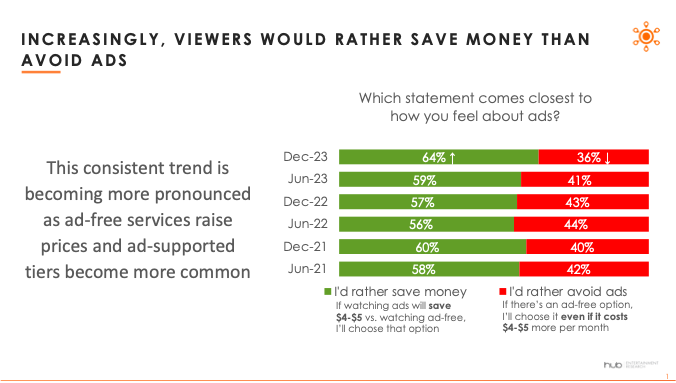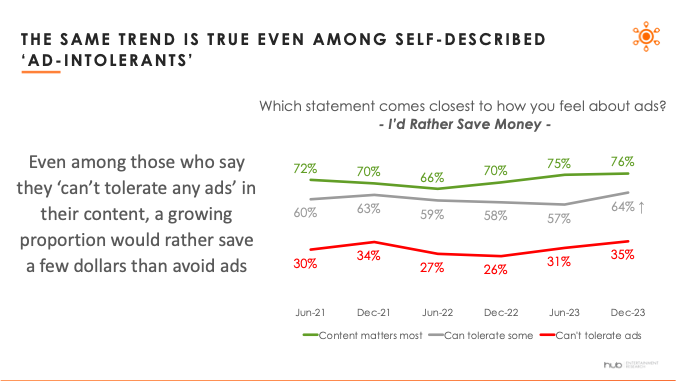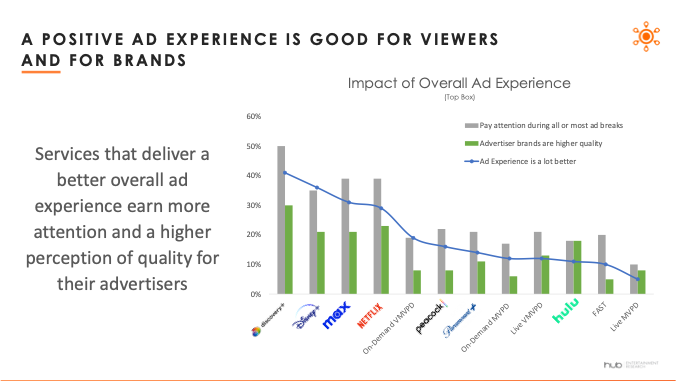Survey: Majority of Viewers Would Switch to Ad-Supported Streaming to Save $5 a Month
More consumers who were previously intolerant toward ads are coming around to ad-supported services to save money

PORTSMOUTH, NH—Nearly two thirds of consumers who subscribe to a streaming service would choose an ad-supported version if it saves them $4-$5 per month according to a new survey from Hub Entertainment Research.
According to the researcher’s semi-annual “TV Advertising: Fact vs. Fiction” survey, that percentage is “significantly higher” than just six months ago.

This softening of resistance to ads is a trend that will continue to grow as Hub notes that over the past year, more consumers who call themselves intolerant toward ads are saying they would in fact opt for an ad-supported service to save money.

That said, consumers’ tolerance for advertising is not unlimited: All things being equal, Hub said that nearly four in ten viewers would choose a streaming service over another if it had a lighter ad load.
In addition, nearly 50% of those surveyed said they pay more attention when ad breaks are shorter, and that those advertisers in services with shorter ad breaks are viewed as “higher quality,” Hub said.

What is considered to be a “reasonable” ad break? Hub's survey showed that most viewers consider ad breaks reasonable if they are one minute or shorter. Ninety seconds is the tipping point where most viewers no longer consider a break reasonable.
Although ad-supported streaming services have been available since the launch of Hulu in 2008, it was Netflix’s introduction of an ad-supported version of its service in 2022 that started a trend that saw its competitors, including Disney+ and Max, among others, to launch their own ad-supported versions in 2023.
Get the TV Tech Newsletter
The professional video industry's #1 source for news, trends and product and tech information. Sign up below.
Hub said that although there is widespread acceptance of advertising in streaming video, there is still opportunity to sign up new subscribers. Most consumers are not aware these services have introduced lower cost ad-supported tiers. Aggressive marketing of the less expensive options can attract viewers who have not yet subscribed to a service because of perceived high cost, Hub said.
Hub added that streaming video currently provides a better environment for their messages than traditional linear TV because the lower ad loads on most services are generally within the boundaries of what viewers consider reasonable. As a result, they are paying more attention to the ads, and thinking more positively about the brands, Hub said.
“As consumers begin to get hit with the double whammy of needing multiple subscriptions to get their entertainment, coupled with significant price increases, opting in for advertising becomes more appealing to them,” said Mark Loughney, senior consultant to Hub. “And as long as providers stick to reasonable ad loads, it’s a win for them and their advertisers as well.”
These findings are from Hub’s 2023 “TV Advertising: Fact vs. Fiction” report, based on a survey conducted among 3,000 US consumers age 14-74, who watch at least 1 hour of TV per week. Interviews were conducted in November 2023 and explored consumers’ attitudes toward advertising, how it differs across video platforms, and how ad strategy affects viewer engagement. A free excerpt of the findings is available on Hub’s website.
Tom has covered the broadcast technology market for the past 25 years, including three years handling member communications for the National Association of Broadcasters followed by a year as editor of Video Technology News and DTV Business executive newsletters for Phillips Publishing. In 1999 he launched digitalbroadcasting.com for internet B2B portal Verticalnet. He is also a charter member of the CTA's Academy of Digital TV Pioneers. Since 2001, he has been editor-in-chief of TV Tech (www.tvtech.com), the leading source of news and information on broadcast and related media technology and is a frequent contributor and moderator to the brand’s Tech Leadership events.

